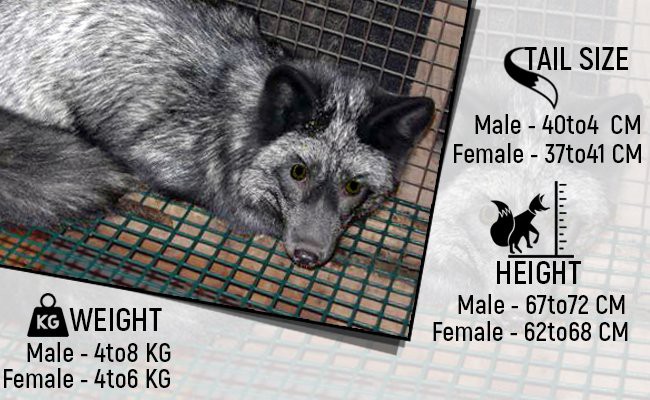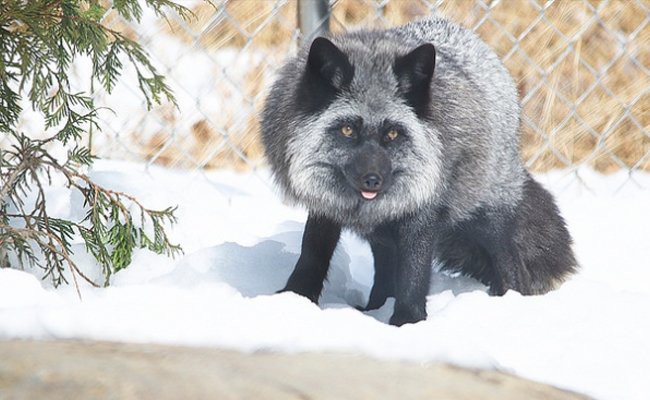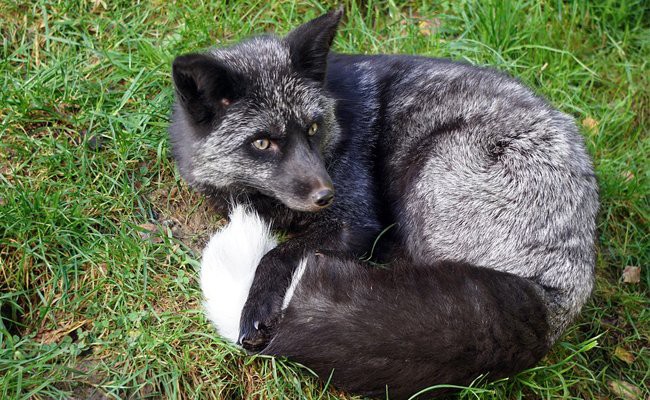Though it may sound odd for some, it is a well-documented fact that the red fox and silver fox belongs to the same species called as Vulpes vulpes. In other words, the melanistic variety of a red fox is generally referred to as the silver fox.
Foxes belong to the family of dogs, the Canidae, earning them the nickname canids. Silver foxes are also called as Black Foxes as their rump hair is silver in color and this stands out against the black fur background.
Silver fox can be found in different color variants – some are cinereous in nature (ash grey look, either grey color tint plus copper brown or resembles ash color), some appear in bluish-grey color, and some are generally in black color except a small streak of white color on the tail tip.
Traditionally, silver foxes skin were always sought after for their quality and texture, and their fur was mostly worn by the nobles and elite in China, Western Europe, and Russia.
Another interesting aspect about silver foxes is that they do not spontaneously reproduce absolutely with only those sharing the same skin/coat morph and in most cases found to be littermates of the common red fox variety.
In the case of captive populations of silver foxes for their skin and also as pets, they are exclusively bred with those having the same skin color.
Silver Fox Sizes/Weight
The length and weight of silver foxes vary from one geographical location to other. On an average, they can weigh anywhere between 10 to 15 lbs (around 4.5 to 7 kgs). Lengthwise, they can reach around 1 meter or 40 inches (head to tail).
Female foxes are normally small in size compared to their male counterparts.
- Weight – Male – 4 to 8 kgs; Female- 4 to 6 kgs
- Height/ Length – Male (head-body combined)- 67 to 72 cms ; Female (head-body combined)- 62 to 68 cms
- Tail size – Male – 40 to 44 cms; Female- 37 to 41 cms
Silver Fox description includes
- Much wider color ranges, long and thick coats than red foxes.
- Broader, shorter
- Longer white tips on tails, fuller and larger tails.
- An average healthy silver fox looks slightly larger than red foxes.
- They can grow anywhere around 35-50 cms in height.
- Silver fox has soles that are thickly populated with woolly hair and it is difficult to find callous spots.
- Silver fox has hairs that are glossy and soft and it produces a wavy look when watched carefully.
- North American foxes are normally in size compared to their European counterparts.
Silver Fox - Lifespan
As per wildlife records, it is reported that an average healthy silver fox can live anywhere between 3 to 10 years. In case of captive breeding, silver foxes are expected to survive much longer, maybe 3 to 14 years.
Silver Fox Temperament And Behavior
- Mostly, silver foxes are semi-territorial and solitary animals. Their food caches and dens usually lie within their asserted territories.
- The silver fox is naturally monogamous. The dominant female and male fox creates a life-long relationship with one another. The pair occasionally, either for a brief period or a long period meets for grooming or playing purpose, but generally hunts & feed independently.
- Like their canine friends, foxes do not have the ability to howl and bark.
- But mostly they produce a distinct noise referred to as the “Geeker” which normally resembles a chuckle.
- Foxes geekier at times of excitement or during an altercation in defending their respective territories.
Silver Fox Communication
- Foxes generally communicate among themselves in numerous ways. They communicate via different types of body postures and facial expressions like dogs and other carnivores.
- Tail wagging is a common sign when foxes meet their family members and may exhibit aggressive behaviour towards intruding non-family members.
- During dispersal and mating seasons, it is a common sight to see foxes getting killed due to internal fights and altercations.
- In general, foxes are known to be silent animals. But they do exhibit a wide display of calls ranging from screams and barks to locate a mate to warning calls and cubs’ bark seeking attention.
- Faeces and urine are another set of communication tools used by foxes. Urine is normally used to mark their territories and faeces to indicate certain specific states like fertility etc.
- The process of employing smell to inform or communicate with other animals is known as scent marking. Faeces are strategically placed on anything ranging from food remains to the objects in order to communicate with their counterparts in an easy and effective manner.
- The scent glands of foxes are located on their foot pads, faces, and tail. Under normal circumstances, they expel or rub it against any objects. Silver Foxes also uses saliva for marking purposes, mostly on vegetation.
- Foxes use their intricate hearing to hunt insects and mammals. For example – they can locate and hunt a mouse using the sounds and pounce on them 2 – 3 meters to finish their business.
- Smell is also alternatively used to find food other than communication. They have the ability to detect food underground or in a locked bag.
- It is believed that foxes do use smell to recognize any intruders in their area checking out their faeces and urine.
Silver Fox - Food
Normally, they are opportunistic eaters as well as hunters. They prefer carnivorous food but can also consume plant sources when food is scarce. In the forest, they adopt different techniques to hunt down prey.
Small animals and mammals are located using their sounds, and then they spring up to catch the victim and eventually kill them with their bite. If a prey is large in size, they employ rapid pursuit and stalking to hunt them down.
Being opportunistic carnivores or omnivorous, their wide range of intake includes
- Human Food Waste
- Commercial dog foods and cat foods
- Grains, Nuts, Seeds, and Shoots
- Vegetables and Fruits
- Insects & Invertebrates
- Amphibians & Small lizards
- Birds and Eggs
- Rabbits and Rodents
How to feed a captive/pet silver fox?
Some tips to feed a captive fox:
Start by feeding your fox – 2 times daily (breakfast & tea). Keep them consistent and balanced (not more than 40 g of full diet including cooked veggies and raw meat).
A nutritious and balanced diet will include more prey items such as
- Cooked and raw vegetables.
- Fresh fruits and berries.
- Commercial diets – Wet and dry complete dogs and cats diets.
- Raw meat (with or without bones) such as heart, kidneys, and liver.
- Eggs include chicken and goose, duck, and Quail.
- Earthworms, wax moths, waxworms, locusts, and crickets.
- Rabbits and rats, mice, game birds and wild poultry, and Chicks etc.
Silver fox treats can include
The majority of a fox diet must consist of insects and prey items, but fox treats can consist of
- Boneless cooked meats
- Coconut oil
- Cottage Cheese
- Veggies and berries, dry fruits
- Nuts and seeds
- Yoghurt and Honey
What foods silver fox cannot eat or must avoid or should not be fed with?
A general thumb rule states that it is better to avoid foods which you cannot feed your dogs and cats. Some of the food items that can be avoided are
- Uncooked fish should not exceed 10% of total fox diet because this can cause in some cases a disease known as Chastek paralysis.
- Chastek paralysis usually occurs when a fox is fed with 10% or exceeding quantities of certain fish varieties leading to acute vitamin deficiency. It can be cured in normal cases by administering a specific dosage of thiamine.
A few of the food items that are considered unsafe for silver foxes
- Alcohol
- Caffeine
- Chocolate
- Fast foods such as French fries etc.
- Grapes
- Onions and garlic in exceeding quantities
- Raisins
- Avocado
- Cooked bones
- Dairy products
- Mushrooms
Kindly remember that food items that are easily digestible by humans can be deadly fatal for animals including cats, dogs, and foxes.
How does a fox cub feed?
Right from their birth until they turn four weeks old, a fox cubs’ staple diet is mother’s milk. Then, they slowly move to solid food and at the same time continue their intake of mother’s milk.
Adult foxes generally provide those foods normally found in the zone where the Fox family lives to their cubs. Vixens are very attached and protective of their cubs at least for a period of 7 months from birth.
Silver Fox Pets
In general, a silver fox is a melanistic form of the red fox which is usually found in the wild. But when it comes to domesticated fox, it is the Russian red fox we are talking about.
The goal is to develop tamed foxes which carry the melanistic character obviously obtained through internal selective breeding.
The main area of contention is that these domesticated foxes are not suitable to survive in their natural habitat due to captive breeding and adult wild silver foxes will also find it very difficult to adjust to city life.
But before we get started with this topic in detail, it is pertinent to understand certain issues that need clarification.
Is it advisable to have a silver fox as a pet?
- No, the reason is simple and clear. Even though the process of domesticating the silver fox had started some time ago, it is necessary to admit that we are still in the process of creating a silver fox that is completely friendly and not elusive in nature.
- It is undeniable that through selective breeding we have achieved quite a progress in this front but ultimately the target we need to achieve in this regard is far too away even in this world of technological progress and development.
- Moreover, the cost involved in maintaining a silver fox as pet costs a bomb. They cost more than US$ 7000 for top quality captive breeds. Taking all these things into perspective, it is recommended that you think twice before acquiring a silver fox as a pet just for the sake of doing so.
Tips and guidelines to maintain silver foxes as pets
The concept to remain different from the crowd and make choices that are exclusive and unique is the thumb rule followed by many well-to-do people in our society.
The greater question is whether the decision they have taken is wise or not, and this applies to even select a silver fox as a pet animal. In the first place, let us start by discussing the tips and guidelines regarding silver foxes as pets.
Whether it is legal to maintain silver foxes as domestic pets – Legally speaking many countries do allow not only foxes but certain exotic species of animals and birds to be kept and raised in captivity. But the catch is that
- The animal or bird which we wish to raise must be in need of immediate help and maintenance. Healthy wild animals are not allowed to be raised under captive conditions.
- The respective government authority must be informed so that they get the best advice on food, medical treatment, behavioural skills etc. to ensure the safety and security of both the animal and the rescuer.
Foxes as domesticated Pets – How it all began?
- At present, there is a countless number of centres or farms that raises and sells silver foxes as pet animals. But however, this does not justify the case that silver foxes are suitable enough to live and move with humans just like that.
- Nonetheless, it has been proved that foxes like other wild animals can be trained and tamed, as exhibited by Dmitry K. Belyaev, the famous Russian scientist in the 50s.
- In a brief, Dmitry with the help of his team started by collecting wild foxes and segregated them into various categories based on their willingness to adapt to human presence. He continued with this experiment for years and later arrived at what we now know as the domesticated Russian red fox.
- These captive foxes normally behave like dogs, going twice an annum into heat, licking the owner like a dog normally does, and have also have learned to raise their tails.
Foxes’ smell or odour
- It is not clear whether Dmitry had tried to subdue the odour released by the fox while experimenting with captive breeding.
- The foul and penetrating odour of the foxes might also be the reason why foxes are not preferred as domestic pets over dogs and cats by humans.
- In spite of the fact that domesticated foxes are affectionate, gorgeous, and smart, the writing is clear on the wall, foxes are utterly smelly.
Foxes behavioural traits
Some of the behavioural traits of a fox that may act as a deterrent in keeping them as pets
- Highly incompatible and restless with other animals or pets.
- Their hunting instincts are so strong that they get into fights easily with other birds and pets and eventually end up finishing them off.
- Dogs normally find it difficult to adapt to the odour generated from a fox’s body, and in most cases, hostility prevails.
- The foxes by nature save/hide their preys’ for later consumption and it is impractical to hide their preys’ in captivity as such.
How to breed a silver fox in captivity?
The other valid keep points to keep in mind
- A Large garden of at least 820 sq. feet secured and fenced to start with. But do keep in mind, foxes are known for their escapist attitude.
- The enclosure might stink horribly as the foxes use their faeces and urine to demarcate their territory.
In essence, raising a silver fox under captivity is more of a burden than a pleasure to both the fox and its owner.
Silver Fox Fur Coat
For the pelt quality to be considered as superior in nature, certain factors must be satisfied:
- Glossy and shiny black fur with a bluish tinge on the neck
- Silver hairs must be neither prominent nor white. Basically, pure bands are required.
- Silver fur distribution must be even.
- The fur must be smooth and silky.
- Next, the sheen of the coat must be prominent reflecting the location and the health of the animal and also the hair finesse is very important.
- The weight must not drop below 1 lbs at any cost, bigger the size higher the value.
- Normally, heavy thick fur is regarded as most valuable and handsome.
The price range of a silver fox fur coat
General and silver fox fur coat price range
The silver fox coat in sound condition can fetch a high price in the market. The fur quality of foxes bred in captivity was always better and nice than those from the wild because of extra attention and care.
They are worth between US$ 500 to US$ 2000 based on the condition in certain markets. However, some products are sold at a much higher price for your kind information.
Moreover, the market is dull right now. Coyote NW prices are US$20 for clear bellies and pale colors and heavys. Region 12 prices are somewhere between US$ 12 to US$ 18 for SD & ND.
To buy silver fox fur coats, visit
- eBay
- Amazon
- Vintage-furs
- Etsy
- FurHatWorld
Interesting Facts About Silver Fox
- Foxes are the main area of study in more than 10 countries on around 3 different continents across the globe. The areas of focus include ecology, behavior, fox biology etc.
- Foxes generally call throughout the year and not in the mating period alone.
- Except for Antarctica, foxes can be found on every continent on earth.
- Foxes and cats share many similar behavioral traits. The fox mostly starts his work after the sunset. Like the cats, they hunt using stalk and pounce techniques. The fox-like the cats have spines and sensitive whiskers on their tongues.
- Like a well developed guided supersonic missile, the fox intelligently utilizes the earth’s magnetic pull/field for hunting purpose.
- Known for their curiosity and friendly behavior, foxes play well with their gang members and also with other animals like dogs and cats.
- Silver foxes are accomplished tree climbers.
- Rabies and distemper are the main diseases that afflict the silver fox other than internal parasites, ticks, and fleas. But silver foxes are strong enough to manage sarcoptic mange which commonly attacks the red fox species.
- Silver foxes and silver fox rabbits have nothing in common while the latter is a cute looking rabbit breed.
- In general parlance, an attractive man with grey hair is referred to as a Silver fox.
- According to Marvel Comics, the name of an imaginary character who loves Wolverine is called as Silver Fox.
FAQs
How to identify ill-health in a Silver fox?
The commons signs of ill-health in a silver fox are
- Changes in behavior
- Running nose and eyes
- Bleeding
- Diarrhea
- Loss of appetite
- Weakness or limping on limbs
- Sneezing or wheezing, coughing
- Chewing or scratching
- Swelling and sores
If you witness any of these signs in your pet fox, do not postpone the visit to your vet.
Mention silver foxes medical care.
Regular and frequent checkups are advised since silver fox diseases are not well documented like the ones found in a pet dog or a cat.
Some of the diseases that can affect a silver fox are
- Leptospirosis
- Canine Parvovirus
- Canine Infectious Hepatitis
- Canine Distemper
- Parasite, fleas, and ticks
- Chapter Paralysis
- Hereditary Hyperplastic Gingivitis
- Fox Encephalitis
Vaccinating the fox at regular intervals as recommended by the vet is a must.
What states is it legal to own a fox in the United States?
The states that permit to keep a fox as a pet with strict guidelines are
- Wyoming
- Wisconsin
- Virginia
- Oklahoma
- Ohio
- Minnesota
- Michigan
- Iowa
- Indiana
- Illinois
- Arkansas
Can I have silver foxes as pets?
Although certain states in America permit to have them as pets, it is better not to own a fox as pets because wild animals like foxes are solitary animals. There is no guarantee that they will remain friends even after extensive domestication. Moreover, the cost of owning a silver fox is over the top for an average earning persons. And keep in mind, they smell awful.
How much is a domesticated silver fox?
A domesticated silver fox can cost anywhere between US$ 7000 and US$ 10,000 based on the breeder’s reputation, breed quality etc. But many silver fox breeds are available from US$ 2000 but the breed reputation is quite difficult to authenticate.
Are silver foxes rare?
No, they are just the melanistic version of the existing red foxes found in Europe, America etc. Remember, silver foxes do not necessarily reproduce only with the same coat family and can also be red fox littermates in general. Captive silver foxes are mostly mated with the same color counterparts.
What is the lifespan of a silver fox?
Based on their habitat it may vary. In the forest, they can live for a maximum of 5 years whereas captive fox breeds are strong enough to last anywhere between 3 to 14 years if provided with the right kind of care and affection.
Where is the silver fox found?
They are mostly found in North America’s southern part extending from Canada’s southern portion, and all the way down to Northern Columbia and Venezuela.
Is it legal to own a silver fox in California?
According to the California Department of Fish and Wildlife, foxes are included in their restricted list which means if a person is found to own a fox as a pet in California, the fox will be exterminated.
Are silver foxes an endangered animal?
When it comes to conservation, a silver fox is totally dependent on the health and welfare of the red fox species as they are considered as their parent breed.
What is the meaning of silver fox in local parlance?
It is used to denote an appealing, old man with grey color hair.
Are foxes prone to attack humans?
Very rarely a fox will attack humans. At times when they are depressed, they can bite.

















